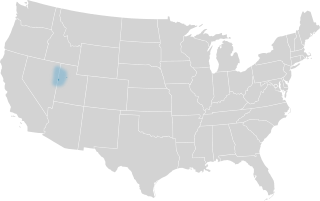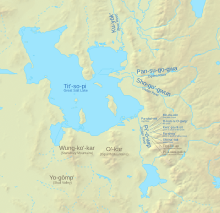Gosiute dialect
| Gosiute | |
|---|---|
| Native to | United States |
| Region | Great Basin |
| Ethnicity | Goshute |
Native speakers | 30 (2017)[1] |
| Language codes | |
| ISO 639-3 | – |
| Glottolog | gosi1242 Gosiute |
 Distribution of Gosiute | |

Gosiute is a dialect of the endangered Shoshoni language historically spoken by the Goshute people of the American Great Basin in modern Nevada and Utah. Modern Gosiute speaking communities include the Confederated Tribes of the Goshute Reservation and the Skull Valley Band of Goshute Indians.[2][3][4]

Status
Historical
20th century
Research by Wick R. Miller documenting the use of Gosiute in family settings on the Goshute Reservation in the 1960s reported the dialect to remain in use as primary means of communication and described comparatively low displacement by English, a fact attributed to the reservation's geographic isolation.[6] Miller additionally reported that younger speakers tended to use Gosiute most, though noted that such a tendency could be a function of the development of English proficiency with age. Monolingual speakers of Gosiute were reported as recently as 1970.[7]
By 1994, language transmission to youth on the under 18 on the Goshute Reservation had become uncommon although fluent speakers represented the majority of the tribal members over 26 years of age.[8]
21st century
An estimated 20 to 30 fluent speakers of the dialect remain including only four in the Skull Valley band, though a number more are passive speakers.[3][4] Although a few children in Goshute communities continue to learn the dialect as their first language, the majority of fluent speakers are over 50.[9][10]
Phonology
Distinct from other dialects of Shoshoni is the Gosiute use of the interdental affricate [t̪θ] in the place of the strident alveolar affricate [ts].[11] Speakers of Gosiute may also drop the initial [h].[12]
Documentation
A great deal of early documentation of Gosiute was carried out by ethnobotanist and ethnographer Ralph Chamberlin who compiled and published Gosiute plant, animal, and place names in the first decades of the 20th century.[13][14]
Linguist Wick R. Miller published a number of works on Shoshoni including a 1972 dictionary and collection of texts that includes several Gosiute texts.[15]
The description of Shoshoni in Volume 17 of the Handbook of North American Indians is based on the Gosiute dialect.[16]
Revitalization efforts
A 1997 plan to store nuclear waste on the Skull Valley Reservation allotted funds to develop a cultural center with language programs however the plans were halted.[17]
The Ibapah primary school taught classes in Gosiute in the 2000s although such courses have since stopped.[18][19]
References
- ^ Brown, Heeni. "Native Americans here to get language revitalisation tips", Te Ao - Māori News, Auckland, 10 October 2017. Retrieved on 21 September 2019.
- ^ Cox, Paul Alan (2000-01-07). "Will Tribal Knowledge Survive the Millennium?". Science. 287 (5450): 44–45. doi:10.1126/science.287.5450.44. ISSN 0036-8075. PMID 10644221. S2CID 36334363.
- ^ a b Davies, Lincoln (2009-01-01). "Skull Valley Crossroads: Reconciling Native Sovereignty and the Federal Trust". Maryland Law Review. 68 (2): 290. ISSN 0025-4282.
- ^ a b Fedarko, Kevin (2000-05-01). "In the Valley of the Shadow". Outside Online. Retrieved 2019-09-22.
- ^ Fowler, Don D. (1971). "Anthropology of the Numa: John Wesley Powell's Manuscripts on the Numic Peoples of Western North America, 1868-1880". Smithsonian Contributions to Anthropology (14). Washington DC: Smithsonian Institution Press: 1–307. doi:10.5479/si.00810223.14.1. S2CID 162581418.
- ^ Miller, Wick (1996). "Language Socialization and Differentiation in Small Societies: The Shoshoni and Guarijío". Social Interaction, Social Context, and Language: Essays in Honor of Susan Ervin-Tripp. Psychology Press. ISBN 9780805814989.
- ^ Miller, Wick R. (1971). "The Death of Language or Serendipity among the Shoshoni". Anthropological Linguistics. 13 (3): 114–120. ISSN 0003-5483. JSTOR 30029285.
- ^ Defa, Dennis R.; Begay, David; Defa, Dennis; Duncan, Clifford; Holt, Ronald; Maryboy, Nancy; McPherson, Robert S.; Parry, Mae; Tom, Gary (2000), Cuch, Forrest S. (ed.), "The Goshute Indians of Utah", History Of Utah's American Indians, University Press of Colorado, pp. 73–122, ISBN 9780913738481, JSTOR j.ctt46nwms.6
- ^ Asher, R. E.; Moseley, Christopher (2018-04-19). Atlas of the World's Languages. Routledge. ISBN 9781317851080.
- ^ "Shoshoni". Ethnologue. Retrieved 2019-09-21.
- ^ Elzinga, Dirk Allen (1999). "The consonants of Gosiute".
{{cite journal}}: Cite journal requires|journal=(help) - ^ McLaughlin, John E. (1992). "A Counterintuitive Solution in Central Numic Phonology". International Journal of American Linguistics. 58 (2): 158–181. doi:10.1086/ijal.58.2.3519754. ISSN 0020-7071. JSTOR 3519754. S2CID 148250257.
- ^ Construction and Operation of an Independent Spent Fuel Storage Installation on the Reservation of the Skull Valley Band of Goshute Indians and the Related Transportation Facility in Tooele County, Utah: Environmental Impact Statement. 2001.
- ^ Minnis, Paul E.; Elisens, Wayne J. (2001-08-01). Biodiversity and Native America. University of Oklahoma Press. ISBN 9780806133454.
- ^ Wick R. Miller. 1972. Newe Natekwinappeh: Shoshoni Stories and Dictionary. University of Utah Anthropological Papers Number 94. Salt Lake City, Utah: University of Utah Press.
- ^ Wick R. Miller. 1996. Sketch of Shoshone, a Uto-Aztecan Language. In Ives Goddard (ed.), Handbook of North American Indians, Volume 17, Languages, 693-720. Washington, D.C.: Smithsonian Institution.
- ^ Rosier, Paul C. (2003). Native American Issues. Greenwood Publishing Group. ISBN 9780313320026.
- ^ "Native languages must be saved, educators say". The Salt Lake Tribune. Retrieved 2019-09-23.
- ^ Dalrymple, Carol (February 17, 2009). "WE SHALL REMAIN THE GOSHUTE" (PDF). KUED.
